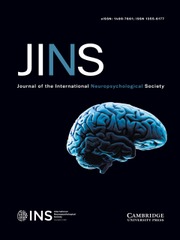Article contents
Validation of the NIH Toolbox-Cognition Battery against legacy neurocognitive measures in adults with cognitive impairments: An exploratory analysis
Published online by Cambridge University Press: 05 September 2022
Abstract
The purpose of this exploratory study was to describe associations between NIH Toolbox-Cognition Battery subtests and legacy measures of neurocognitive function in two samples with neurological conditions (stroke and sickle cell disease (SCD)).
This exploratory secondary analysis uses data from two studies that assessed cognition at one time point using the NIH Toolbox-Cognition Battery, the Repeatable Battery for the Assessment of Neuropsychological Status (RBANS), and subtests from the Delis-Kaplan Executive Functions System (DKEFS). People with stroke (n = 26) and SCD (n = 64) were included. Associations between the NIH Toolbox-Cognition Battery subtests and corresponding legacy measures were examined using linear correlations, Bland–Altman analysis, and Lin’s Concordance Correlation Coefficient.
Linear correlations and Lin’s Concordance Correlation Coefficient were poor to strong in both samples on NIH Toolbox-CB subtests: Flanker Inhibitory Control and Attention (r = .35 to .48, Lin CCC = .27 to .37), Pattern Comparison Processing Speed (r = .40 to .65, Lin CCC = .37 to .62), Picture Sequence Memory (r = .19 to .55, Lin CCC = .18 to .48), Dimensional Change Card Sort (r = .39 to .77, Lin CCC = .38 to .63), Fluid Cognition Composite (r = .88 to .90, Lin CCC = .60 to .79), and Total Cognition Composite (r = .64 to .83, Lin CCC = .60 to .78). Bland–Altman analyses demonstrated wide limits of agreement across all subtests (–3.17 to 3.78).
The NIH Toolbox-Cognition Battery subtests may behave similarly to legacy measures as an overall assessment of cognition across samples at risk for neurological impairment. Findings should be replicated across additional clinical samples.
Information
- Type
- Research Article
- Information
- Journal of the International Neuropsychological Society , Volume 29 , Issue 5 , June 2023 , pp. 472 - 479
- Copyright
- Copyright © INS. Published by Cambridge University Press, 2022
References
- 5
- Cited by

